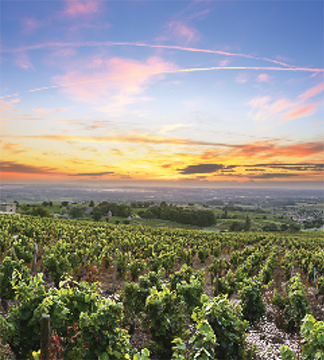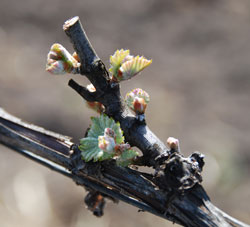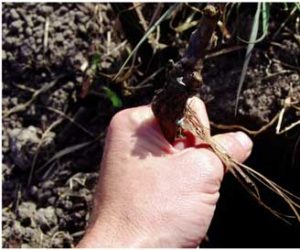 Of all the various families of wine varietals (Burgundian, Bordelais, Alsatian, etc.) the varietals commonly associated with the Rhône Valley of France offer American viticulturists an amazing array of delicious grapes that can produce palatable (or even delicious) wine all over the Fruited Plain. The vines are generally well-adapted to New World soils and exhibit moderate to high vigor for good production of wine per vine.
Of all the various families of wine varietals (Burgundian, Bordelais, Alsatian, etc.) the varietals commonly associated with the Rhône Valley of France offer American viticulturists an amazing array of delicious grapes that can produce palatable (or even delicious) wine all over the Fruited Plain. The vines are generally well-adapted to New World soils and exhibit moderate to high vigor for good production of wine per vine.
At the risk of sounding Pollyanna-ish, there may be a Rhône varietal that will make drinkable wine in just about every area of the United States where wine can be grown.
To begin with, let’s make a few general statements about areas that would be amenable to growing Rhône varietal winegrapes:
• Winter chilling requirement: 150+ hours under 45 °F (7 °C) per winter/dormancy period.
• Degree-day accumulation between Zone 2 and Zone 4. (2500-4000 degree days via the Winkler scale)
• Soil and water that have been tested and shown to support and encourage varietal winegrape production.
• Location is in an area that has shown some success in producing wines from Vitis vinifera (European) heritage.
Now that we’ve worked through the bullet points, let’s look at all the options for planting Rhône varietals and decide what style of wine we want to grow.
I generally suggest to home grape growers that they limit their vineyard to a single varietal if their vineyard is a half-acre or less. This simplifies cultural practices and harvest — not having to manage the vineyard in tiny blocks, and harvest and crush piecemeal. If you had two acres, I could see doing a great Rhône blend. One half-acre of Syrah, Grenache, Mourvèdre and Cinsault would make a wonderful blended wine, and tweaking it to one acre of Grenache or one acre of Syrah (and shrinking the other blocks) would be good in many locales.
Clearly Rhône reds (and whites) are blending grapes. Sure we’ve had delicious Syrahs and Viogniers, but those wines are more of a New World expression (of our love of pure varietal wine) than the nature of these vines as they are made in France. Very few Rhône wines are varietal. Condrieu and Château Grillet are purely Viognier, but most other wines from the region contain multiple varietals. Châteauneuf-du-Pape commonly has more than a dozen varieties blended into a single wine.
Single varietal Rhône wines (such as Aussie Shiraz/Syrah or California Grenache) often seem clunky and one dimensional to me, and are almost always improved by blending.
Rhône varietals to try
Red:
Carignan (Carignane): The Carignan grape is responsible for untold millions of cases of jug wine from Southern France and California’s Central Valley. Yet under the right conditions — mature vines, restricted yields, careful winemaking – it can make perfectly respectable wine and, if used in moderation, add a useful flavor, color and tannin dimension to blends.
Cinsault (Cinsaut): A high-yielding, early-ripening, hot-weather red grape, generally used in blends. Cinsault tends to be low in tannin, and is often added to blends to add a spicy component. Not often found as a varietal bottling. Among the grape’s claim to fame is being half the genetic cross (along with Pinot Noir) behind the South African Pinotage grape.
Counoise: Counoise is a key component of many Châteauneuf-du-Pape wines. It is a deep purple-red, and has a rich spicy character, with flavors of anise, strawberries and blueberries. Counoise’s moderate alcohol and tannins make it a good complement for Syrah, balancing that grape’s characteristic intense spice, strong tannins and high alcohol. It is said to have been introduced to Châteauneuf-du-Pape from Spain by a papal officer who offered it to Pope Urban V when the papacy was based in Avignon in the mid-14th century. In the vineyards of Châteauneuf-du-Pape, it occupied a prominent place in the wines of the celebrated Château la Nerthe in the late 19th century, and saw a rebirth at Château de Beaucastel under Jacques Perrin. In California, Tablas Creek Vineyard imported Counoise cuttings from Château de Beaucastel in 1990, and the BATF recognized the varietal in 2000.
Grenache: Probably the world’s most widely planted red grape, largely in France and Spain. Grenache’s reputation would soar if growers treated it more respectfully. It should be planted in more suitable locations throughout the world. Early-budding and late-ripening, Grenache has a tendency toward high sugar and alcohol levels if not planted in the right areas or cropped back. It needs sandy, devigorated soil where it can produce exquisite, luscious wines.
Mourvèdre (Mataro): Like Grenache, the Mourvèdre grape is probably Spanish (where it goes by the name Monastrell) in origin. Under the name Mataro (or no name at all), it has been part of California “field blends” for more than a century. It produces sturdy wines with good acid and some astringency, and can develop enticing blackberry aromas and flavors – meaty, intense wines that age well. Mourvèdre is notable in France as the prime ingredient in the red and rose wines of Bandol. California’s early Rhône Rangers were responsible for rescuing precious acreage of old Mourvèdre plantings in the 1970s.
Syrah (Shiraz): In the vineyard and the winery, Syrah is typically an easy grape to work with – healthy, early-ripening, resistant to mildew and rot, suitable for winemaking in a variety of styles. At its best, Syrah can slug it out with high-end Cabernet and Pinot Noir. This is accomplished when the vines are not allowed to over bear. As a single varietal, Syrah is the basis for the great reds of the Northern Rhône; as an ingredient in blends, it contributes much of the character and aging potential for wines of the Southern Rhône. Shiraz (in Australia) has a distinguished history Down Under as well, being the most widely planted red grape. The variety also has a long track record in California – including a record of confusion with Petite Sirah, an unrelated grape.
Petite Sirah (Durif): Petite Sirah is a cross between the two grapes, Syrah and Peloursin, developed in France in 1880 by Dr. Francois Durif. Though not known to be grown anywhere in France today, it is grown in California and Australia. “Petite” hardly describes its character. The grape produces a wine dark in color (blue-red hues) with great extraction and big tannins that will reward those with the patience to cellar. Even younger wines, however, will benefit from decanting.
White:
Grenache Blanc: Grenache Blanc is the white-berried equivalent of Grenache Noir, and, like its red variant, is drought-resistant, vigorous, and easy to graft. The varietal originated in Spain and still plays a role in the wines of Rioja and Navarre. From Spain, it spread to France where it has thrived in the vineyards of the Rhône valley and Châteauneuf-du-Pape. It is the fourth most commonly planted white grape varietal in France, comprising over 37,000 acres in Roussillon alone. Its high-sugar, high-acid, straw-colored bunches produce wines that are high in alcohol, with green apple flavors and aromas. Although it can stand confidently on its own, its crispness and long finish make it a tremendous blending component. In Châteauneuf-du-Pape, the crisp acidity of Grenache Blanc is often used to balance the honeyed richness of Roussanne. In California, Tablas Creek Vineyard imported Grenache Blanc cuttings from Château de Beaucastel in 1992, and the BATF recognized the varietal as distinct from Grenache Noir in 2003.
Marsanne: The white workhorse grape of the Southern Rhône and much of Southern France, and widely planted in Australia as well. Marsanne is a sturdy, hardy grape that produces a full-bodied wine — with the heft of a good Chardonnay. Its relatively simple fruity flavors make it a natural candidate for a blending base, though interesting varietal Marsanne can also be produced.
Muscat Blanc: Almost certainly the oldest known wine grape varietal, Muscat Blanc à Petits Grains has a noble history. It was established in Gaul by the Romans, and may even have been brought to Marseilles by the Greeks before that. From the south of France, it spread throughout the Mediterranean, as well as north into Alsace and Germany. Currently, it is grown almost everywhere in Europe, including Russia, Hungary, the Crimean Peninsula and Greece (where it is one of the country’s principal grapes). Its berries, as the name suggests, are small and produce wines with elegantly floral aromatics. In the Southern Rhône the grape is often blended with Clairette to make the sparkling Clairette de Die, and vinified alone to make the sweet Beaumes-de-Venise wines.
Picpoul/Piquepoul Blanc: Native to the Languedoc area, Piquepoul means “lip stinger,” an apt description of its high acidity must. Prior to the phylloxera invasion, Picquepoul was popular, and often blended with the Clairette. When vineyards were replanted in the early 1900s, however, its low yields did not gain it prominent placement in the vineyards of Southern France. It is still used in the wines of Châteauneuf-du-Pape, and has floral aromatics.
Roussanne: Roussanne’s name comes from its russet-colored skin. The grapes are somewhat prone to rot, but high in acidity and in aromatic qualities. The same qualities that make Roussanne a racy, lively wine also give it the potential to age – setting it apart from the other Rhône whites. In the Southern Rhône, Roussanne is often the premium component of white blends.
Ugni Blanc: This ubiquitous grape is perhaps better known by its Italian name of Trebbiano. In Cognac, where it comprises almost 95% of all vines planted and forms the base for brandy, it is also known as St. Emilion. Although very few people in the United States have heard of it, the varietal is France’s most planted grape, outnumbering Chardonnay five to one in the 1980s. The varietal is so prolific that it produces more wine than any other grape (even though Grenache and Spain’s Airén may cover a larger vineyard area). It is relatively low in alcohol but high in acidity, and, when not overproduced, makes wines with delicate fruit and floral aromas. The US is one of the last wine-producing countries without measurable acreage of Ugni Blanc. In addition to France and Italy, it is widely grown in Australia, South Africa and even Southeast Asia.
Viognier: Viognier may be the world’s least widely planted premium grape — but currently one of the most prized. In the vineyard, yields and acid levels tend to be low, and susceptibility to disease and rot high. In the winery, it is temperamental. But once in the bottle or the glass, a well-made Viognier comes with a deep, yellow color and an exquisite, exotic bouquet – apricots, pears, tropical fruits. In the Northern Rhône, Viognier is the basis of the wines of Condrieu and Château-Grillet. In the US, it has a short but accelerating history. In 1996, for example, there were 645 acres of Viognier vines in California; by 2004, planted acres had grown to over 2,000. Seems to do best in granitic, schistic, and mica-laden soils.
Conclusion
The combined diversity of red and white Rhône varietals will not guarantee you can grow Vitis vinifera (Euro varietals) anywhere in the United States, but it does offer an amazing array of flavors and wine styles for any region that will tolerate vinifera plantings.
Rule of thumb: if no one in your immediate vicinity grows vinifera with any success, you will not do any better. If there are successful vinifera plantings in your area, making delicious wine at least seven out of ten vintages, you should be able to find a Rhône varietal that matches your site and will make wine you will be proud to grow, pick, ferment, and most importantly: drink!






